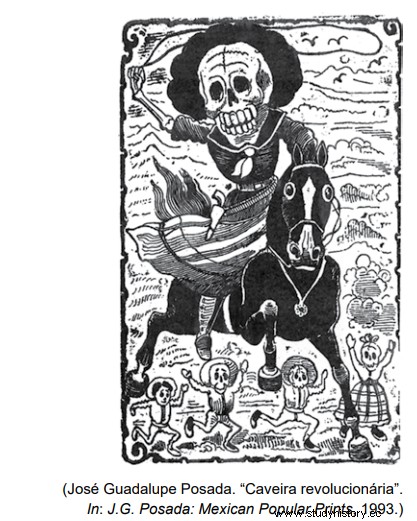Question 02 - UFF 1997 - The Mexican Revolution, which broke out in 1911, and the rise of the Radical Civic Union to the Presidency of the Republic in Argentina, in 1916, express exemplary cases of the oligarchic crises that occurred in Latin America at the beginning of the 20th century. Mark the option that correctly presents an important difference between the two processes mentioned. (A) The Mexican Revolution was conceived by dissident oligarchies from the Porfiriato, while Argentine Radicalism was gestated in the anarchist trade union milieu. (B) In the Mexican case, the unfolding of the The revolutionary movement had strong support from peasant sectors, while Argentine Radicalism was characterized, especially in its beginnings, as a political movement of the urban middle class.(C) The Mexican revolutionary process took a notoriously Bolshevik path after 1917, influenced by the success of the Russian Revolution, unlike Argentine Radicalism, an essentially conservative movement.(D) The Mexican Revolution was, from the beginning, a process of national and multi-class insurgency, while the Radicalism of Ipólito Yrigoyen remained restricted to the social milieu. from the urban middle class.(E) The Mexican Revolution put the social and agrarian question on the scene in a radical, unlike Argentine Radicalism which, from the beginning, showed indifference towards the masses.
Question 03 - FDF 2014 - The Mexican Revolution, which took place in the 1910s, a) resulted in the annexation by the United States of almost half of the Mexican territory. b) included broad mobilization of indigenous and peasant sectors, who fought for the distribution of land to those who lived and worked there. c) caused great land concentration in the interior of the country, ending the agrarian reform program developed in the previous century. d) determined the end of the political hegemony, in the cities and in the countryside, of the bourgeois sectors linked to agro-exports. e) it was a reaction of the rural oligarchies to the process of modernization of the Mexican economy during the previous century.
Question 04 - UFU 2018/2 - “The Mexican Revolution, which marks the beginning of the Contemporary Age in Latin America, (...) defeated the hegemony of the oligarchy, replacing it with an agrarian bourgeoisie, triggering significant changes in the economy, politics, diplomacy, in the social and cultural fields and in the relations between State and Church.” RAMPINELLI, W.J. The Mexican Revolution:its regional reach, precursors, the class struggle and the relationship with native peoples. Revista Espaço Acadêmico, n.126, nov.2011, p.90. Regarding the events involving the Mexican revolutionary process, it is INCORRECT to state that a) Porfírio Diaz, one of the main names of the revolution, defended the carrying out of labor and agrarian reforms already in the course of the revolutionary process, without waiting for the decisions of a future Legislative Power . b) intellectuals played a fundamental role as precursors of the revolution, especially those linked to the middle and lower classes, such as Ricardo Flores Magón. c) the program of the Mexican Liberal Party, of 1906, was the first public document with the exposition of the 52 points that contained the main ideas of the revolution, making a call to the people about the national life. d) Emiliano Zapata commanded the Liberation Army of the South, which was essentially formed by peasants, who did not have a national vision of the revolution, only sought to defend their traditions and their lands.
Question 05 - UNESP 2020 - Observe the engraving.
 Produced in the early 1910s, the engraving represents the Mexican Revolution as marked a) by female participation and recovery of elements of the pre-Columbian tradition. b) for the victory of popular revolutionary projects and for the construction of a new social order. c) by political-diplomatic negotiation and by the high rates of murder of women. d) the interference of foreign countries and the loss of the country's autonomy. e) government repression and the imposition of physical punishment on revolutionaries.
Produced in the early 1910s, the engraving represents the Mexican Revolution as marked a) by female participation and recovery of elements of the pre-Columbian tradition. b) for the victory of popular revolutionary projects and for the construction of a new social order. c) by political-diplomatic negotiation and by the high rates of murder of women. d) the interference of foreign countries and the loss of the country's autonomy. e) government repression and the imposition of physical punishment on revolutionaries. INTRODUCTION 01 - Letter E.02 - Letter B03 - Letter B.04 - Letter A.05 - Letter A.
